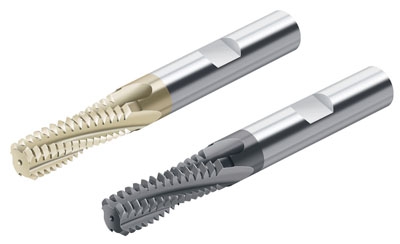
Walter has introduced the Walter Prototyp Supreme TC610 and TC611 solid-carbide thread mills, high performance tools that deliver significant increases in thread quality, milling productivity and process reliability while boosting tool life. The TC610 with 1.5xD and the TC611 with 2xD both offer a new geometry that reduces vibration, produces superior surface finishes, as well as a through coolant design that optimizes chip removal and helps prevent fractures.
The real game changers, though, are Walter's two new grades, according to the company. The thread mills are offered in grades WB10RD and WJ30RC. WB10RD, with its exceptional wear resistance, has shown tool life improvements of 40 percent over other similar thread mills in lab tests. It features TiALN coating with a finishing layer of ZrN. The ZrN layer has a lower affinity for steel, providing lower temperatures in the cutting zone.
The tough WJ30RC grade, with TiALN coating, delivers exceptional process reliability along with improved tool life. It can be run with or without coolant, broadening its areas of application. Importantly, users receive good thread quality from both grades.
The versatile new Walter Prototyp Supreme TC610/611 thread mills are suitable for use with ISO material groups P, M, K, N, S, and O, and can be obtained through the Walter GPS system.
Contact Details
Related Glossary Terms
- coolant
coolant
Fluid that reduces temperature buildup at the tool/workpiece interface during machining. Normally takes the form of a liquid such as soluble or chemical mixtures (semisynthetic, synthetic) but can be pressurized air or other gas. Because of water’s ability to absorb great quantities of heat, it is widely used as a coolant and vehicle for various cutting compounds, with the water-to-compound ratio varying with the machining task. See cutting fluid; semisynthetic cutting fluid; soluble-oil cutting fluid; synthetic cutting fluid.
- gang cutting ( milling)
gang cutting ( milling)
Machining with several cutters mounted on a single arbor, generally for simultaneous cutting.
- milling
milling
Machining operation in which metal or other material is removed by applying power to a rotating cutter. In vertical milling, the cutting tool is mounted vertically on the spindle. In horizontal milling, the cutting tool is mounted horizontally, either directly on the spindle or on an arbor. Horizontal milling is further broken down into conventional milling, where the cutter rotates opposite the direction of feed, or “up” into the workpiece; and climb milling, where the cutter rotates in the direction of feed, or “down” into the workpiece. Milling operations include plane or surface milling, endmilling, facemilling, angle milling, form milling and profiling.
- titanium aluminum nitride ( TiAlN)
titanium aluminum nitride ( TiAlN)
Often used as a tool coating. AlTiN indicates the aluminum content is greater than the titanium. See coated tools.
- wear resistance
wear resistance
Ability of the tool to withstand stresses that cause it to wear during cutting; an attribute linked to alloy composition, base material, thermal conditions, type of tooling and operation and other variables.









